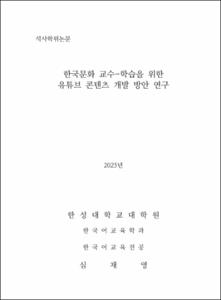한국문화 교수-학습을 위한 유튜브 콘텐츠 개발 방안 연구
= A Study on the Developing YouTube Content for Teaching and Learning Korean Culture
- Files in This Item:
-
-
Download
 200000852930.pdf
기타 데이터 / 5 MB / Adobe PDF
200000852930.pdf
기타 데이터 / 5 MB / Adobe PDF
-
Items in Repository are protected by copyright, with all rights reserved, unless otherwise indicated.